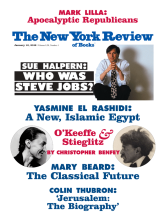In response to:
The Crass, Beautiful Eternal City from the December 22, 2011 issue
To the Editors:
In Ingrid Rowland’s review of Robert Hughes’s Rome: A Cultural, Visual, and Personal History [NYR, December 22, 2011], she cites with approval a passage about Raphael: “What other artist could have painted two little angels…into an Assumption of the Virgin, given them an enchanting air of childish detachment…?” Rowland and Hughes can only be thinking of the Sistine Madonna (1513; Gemäldegalerie, Dresden), an image on canvas most probably designed for display above the tomb of Pope Julius II, whose features appear on the figure of the pope kneeling on clouds at the left of the Virgin and Child, opposite Saint Barbara, patron saint of death. (See Frederick Hartt, History of Italian Renaissance Art, 1974, pp. 466f.) The two angels are mourning, leaning upon a piece of wood representing the coffin lid. This is not an Assumption nor are the angels “detached,” but Hughes has been misled by the popular reproductions of the angels on Christmas cards.
Georgia Sommers Wright
Berkeley, California
Ingrid D. Rowland replies:
I cited with approval a considerably longer passage about Raphael, in which my major point was to show Hughes’s sensitivity. Stricto sensu, to be sure, the Sistine Madonna is appearing in glory rather than being assumed into heaven, but she is certainly an Assunta; that is clear from the silver-gold clouds that surround her. In making this identification, inaccurate on a small scale and both correct and significant in a larger theological sense, Hughes is surely thinking of Titian’s Assumption of the Virgin in Santa Maria Gloriosa dei Frari in Venice. (Similarly, Giorgio Vasari may have been “wrong” to identify the Pythagoras in Raphael’s School of Athens as Saint Matthew, but he was also right in a larger sense; the Greek philosopher does appear as a sort of evangelist.)
If in the same painting Pope Julius is likewise appearing in glory at the Virgin’s right hand in the robes of Saint Sixtus, then the angels have no reason to mourn, and in fact they are doing something much more extraordinary: bearing witness to the epiphany of Mary and the infant Christ. I might call their state of mind “wonder” or “bemusement” rather than “detachment,” but in any case it seems an eminently appropriate theme for Christmas cards.
This Issue
January 12, 2012
Do the Classics Have a Future?
Convenience
Republicans for Revolution



